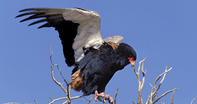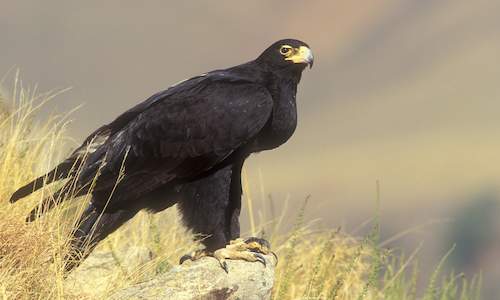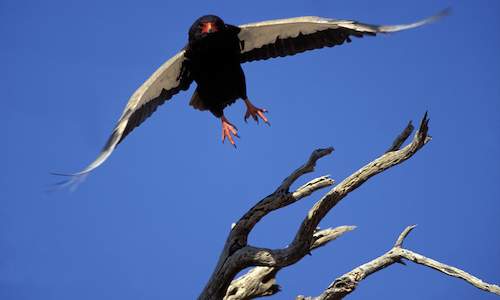
Name
Bateleur Eagle (Terathopius ecaudatus)Appearance
The bateleur eagle is the most famous of the snake eagles. Bateleur is French for ‘tightrope-walker’. This name was probably chosen because of its distinctive aerial acrobatics. The adult bateleur eagle is a medium-sized eagle with black feathers, white under the wings and a black beak.
The brown eyes are surrounded by facial skin that is a strikingly bright red, and devoid of feathers. As if to give a sense of artistic balance, the legs are the same brilliant red as the face.
The bateleur has exceptionally long wings and a short tail so that its feet extend beyond the tail in flight. Unlike most creatures, female bateleur eagles are larger than males and the upper wing-coverts are brown, while the secondary flight feathers are mainly grey.
The immature bateleur eagle’s feathers are a uniform dark brown. Around the third year, this plumage starts to turn into adult colors of black, white and grey. It can take an immature bateleur up to 8 years to shed all their brown plumage and turn in to full adults.
Bateleur Eagle Diet
Bateleur eagles spend 8-9 hours each day in the air looking for food. Their diet includes antelope, mice, birds, snakes, and lizards. In South Africa, the bateleur eagle is often seen scavenging at carcasses or road kills.Bateleur Eagle Breeding
A female will lay a single egg in a nest build in a large tree, which also offers protection. She will usually incubate the egg while the male collects food and sticks for the nest. Sometimes, however, the male incubates as well. After an incubation period of 52-59 days, the baby bateleur eagle hatches.
The hatchling will leave the nest after 110 days, but will continue to receive food from its parents for another 100 days. Only 2% of chicks make it to adulthood.
Bateleur Eagle Behaviour
The bateleur is most commonly seen in rapid, direct flight which is its preferred method of hunting. Up to 300 miles can be covered in an eight-hour-long daily search for food. Due to the extensive area covered each day, the number of eagles in the wild is easily over-estimated in its native sub-Saharan region of Africa, but their numbers are declining.
Bateleur eagles pair for life and stay in the same nest for several years. The courtship aerial display is spectacular, with steep dives by the male at the female. She will roll on her back, presenting her claws and then roll on over to right herself as he hurtles past.
There may be a follow-the-leader dipping and rolling flight or 360-degree lateral ‘barrel’ rolls, which is often accompanied by a very loud slapping of the wings. This striking can be heard by humans for some great distance. This may also be accompanied by very loud crowing calls. Unpaired adults can sometimes be seen near a nest site.
This bird is not rejected by the mating pair and does not help with nesting. The bateleur eagle often sunbathe. They hold their wings straight out to the sides and tipped vertically do a classic ‘phoenix’ pose to follow the sun.
Habitat
Bateleur eagles generally prefer open land – grassland, savanna and woodland habitats, such as arid acacia savanna and mopane woodland, but prefer tree and bush savanna.
They occur across sub-Saharan Africa and in Southern Africa the bateleur eagle is common in South Africa, Mozambique, Zimbabwe, Botswana and northern and eastern Namibia. But, numbers are declining in most of its Southern African range.
 The little sparrow-hawk, the Lowveld’s smallest raptor, is the same size as a dove....
The little sparrow-hawk, the Lowveld’s smallest raptor, is the same size as a dove.... They are striking eagles with contrasting black plumage, red bills and feet and a very short tail....
They are striking eagles with contrasting black plumage, red bills and feet and a very short tail....